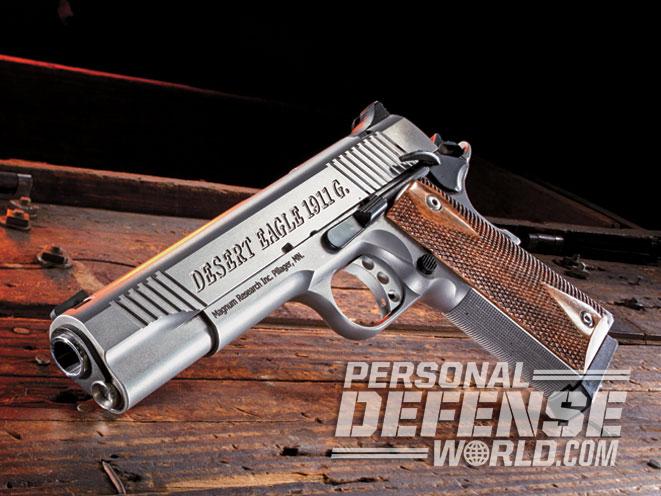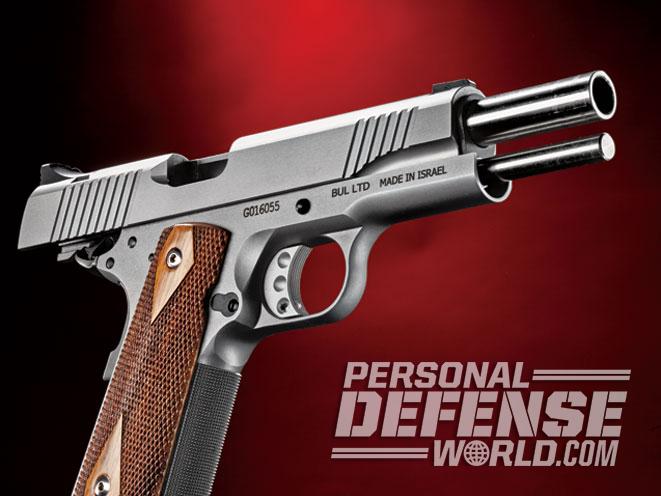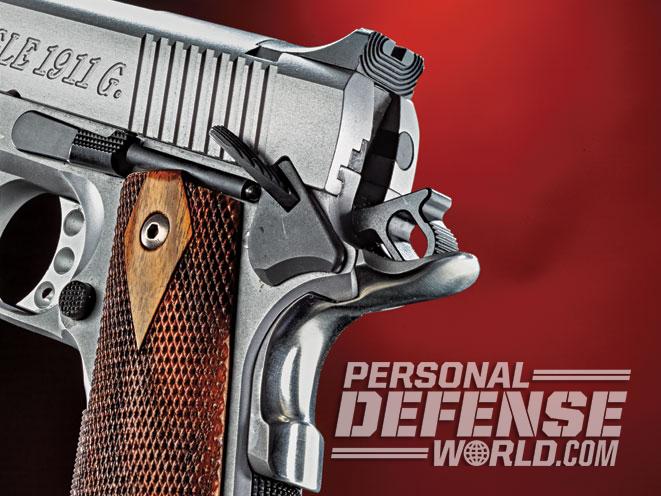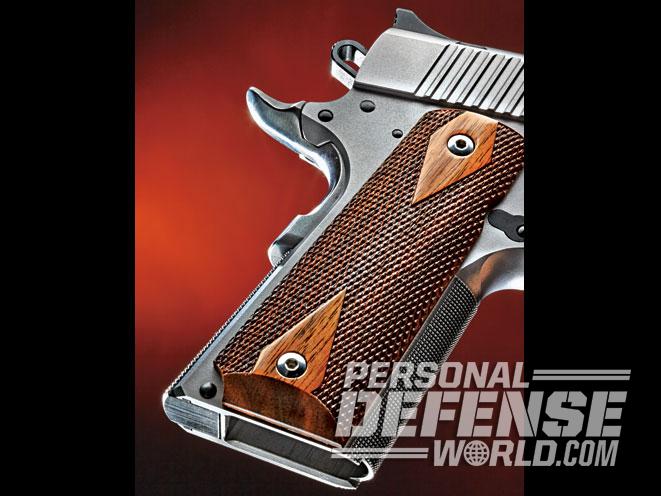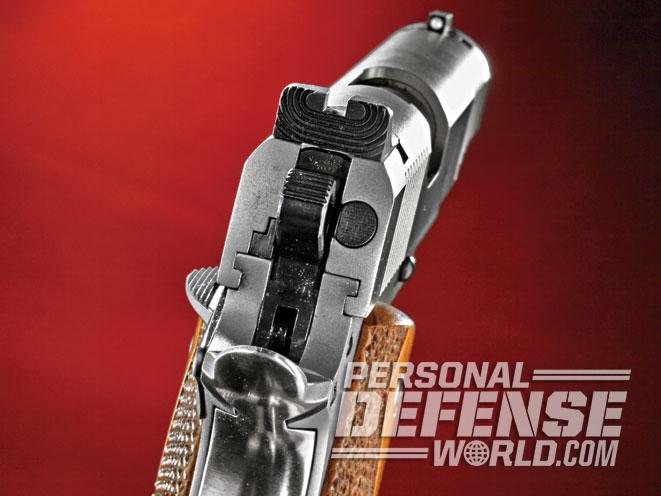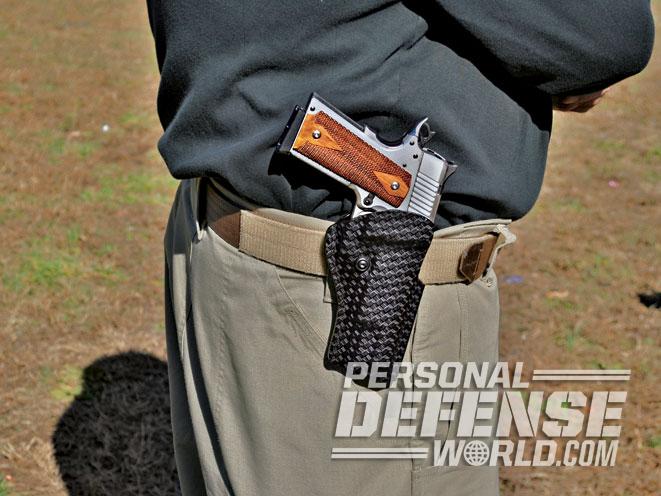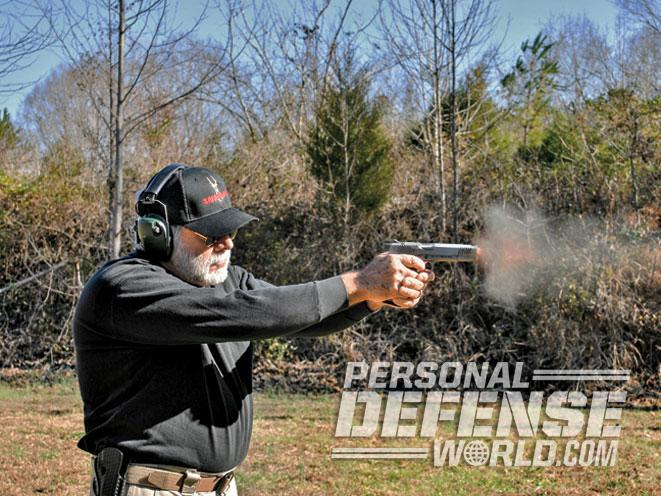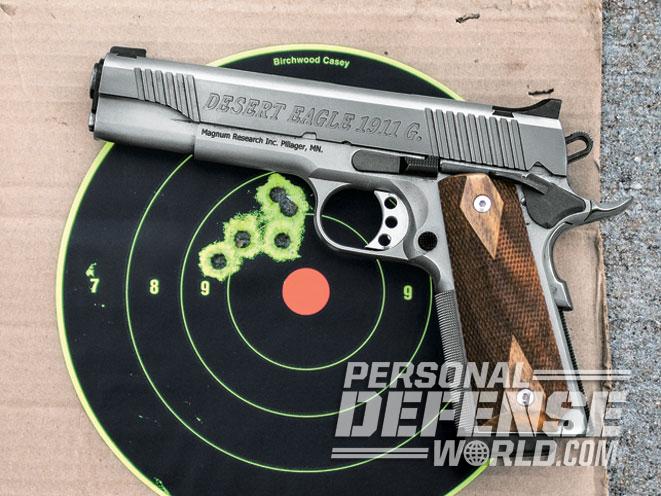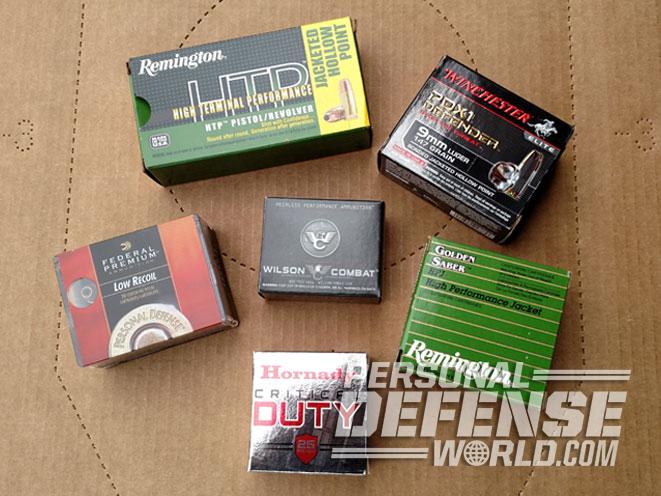Shortly after the parcel delivery service dropped off the box, I opened it and removed the black plastic case it contained. I unsnapped the case’s two catches and took out the 1911 pistol residing therein, removed the magazine and retracted the slide to verify that it was empty. I let the slide run forward and, pointing it in a safe direction, I pulled the trigger. Whereupon I exclaimed “Holy cow!”
The reason for this exclamation of surprise (delight?) was that the trigger on this particular pistol had without a doubt one of the lightest, crispest let-offs of any out-of-the-box 1911 I have used in a very long time. I immediately went to my workshop and retrieved my RCBS trigger-pull gauge, and I was amazed to see that it registered 3.5 pounds because, to be honest about it, it actually felt lighter than that.
Man, was I excited about taking this new offering from Magnum Research, the Desert Eagle 1911 GSS (Government Stainless Steel) made by the Israeli company Bul, to the range.
Advertisement — Continue Reading Below
The backstory on Bul is that it is a privately owned company that was founded in 1990 and specializes in the development, construction and maintenance of indoor shooting ranges in both Israel and abroad. The company began building CZ 75-style and 1911-style pistols in the early 1990s. In 2009, Magnum Research began importing the company’s 1911 pistols and today offer 11 models in Government, Commander and subcompact sizes with blue or stainless steel construction as well as a line with case-hardened frames.
GSS Specs

I became aware of Magnum Research’s new stainless steel pistols—the 1911 GSS, 1911 CSS (Commander) and 1911 USS (Undercover)—late last year.
Except for their lengths and heights, the trio has much in common: stainless steel slides, checkered frames and backstraps, high-profile sights and much more. In fact, the most glaring difference is that the subcompact 1911 USS features an aluminum alloy frame and an adjustable rear sight.
Advertisement — Continue Reading Below
RELATED STORY: Gun Review – Magnum Research’s Baby Desert Eagle III Pistols
While I am a lifelong fan of the 1911 pistol, I must confess to not having much interest in the Commander and subcompact platforms. My experience has been that the two shorter 1911s tend to be finicky with regards to reliability and ammunition tolerance, whereas the Government model’s reliability is legendary, or, as some of my acquaintances put it, “Because that’s the way John Moses designed it!”
As I’ve already described the pistol’s (excellent) trigger, I will go on to tell you what else there is about the Desert Eagle 1911 GSS that impressed me—and there’s quite a bit of it.
Advertisement — Continue Reading Below

First of all, the slide and frame have an attractive (and practical) brushed stainless finish. The round top slide has dual dovetail cuts for mounting a square blade (with a white-dot) front sight and high-profile rear sights. The rear is sloped so as to not hang up when re-holstering the pistol, while its rear face is serrated to cut down on glare. Both can be laterally adjusted for windage. Grasping grooves fore and aft allow you to retract the slide with a variety of grips and from different angles. These grooves also have sharply cut edges so that doing so with wet/oily hands or when wearing gloves is not problematic.
The ejection port has been lowered and flared to make sure that spent cases are removed quickly, while a full-length, stainless steel recoil spring guide rod ensures consistent slide reciprocation and lockup after firing.

The frontstrap of the grip frame features 20-lpi checkering (as does the flat mainspring housing) for a firm purchase. Similarly, reduced metal under the triggerguard allows you to get a high grip on the pistol for improved recoil control. An extended thumb safety and beavertail grip safety with a palm swell allow positive manipulation of the two security devices, while the edges of magazine well are beveled to smooth out reloads. Both of the supplied eight-round magazines feature extended polymer baseplates that not only protect the magazines if they’re dropped on a hard surface but also allow for more positive reloads.
Advertisement — Continue Reading Below
RELATED STORY: DE50SRMB – MRI’s Desert Eagle Mark XIX Pistol with Integral Muzzle Brake
The skeletonized hammer not only looks attractive, but its lighter weight allows for a faster lock time, while the lightweight aluminum trigger can be adjusted for overtravel. The sharply checkered wooden grips improve handling and recoil control and should please the traditionalists among us who have an aversion to polymer pistol components. Lastly, and much to my liking, the slide stop lever has not been extended.
Warhorse Workout
Advertisement — Continue Reading Below

The 1911 GSS comes with just about every “bell and whistle” that today’s serious shooters insist upon with their 1911 pistols—and right out of the box. There’s no waiting for a gunsmith to customize the pistol the way you want it because it is set up that way already!
I ran the 1911 GSS through its paces at my gun club on a brisk afternoon. The accuracy testing was performed from an MTM K-Zone rest at a measured 25 yards with four types of factory ammo and my match handload. As I had expected, the pistol performed best with 230-grain loads with honors going to Hornday’s +P Critical Duty load, which produced an impressive 1.6-inch group. The pistol tended to group a bit to the left, but as I had forgotten to bring my tool kit with the brass drift and hammer, I just had to live with the sights as they were.
RELATED STORY: MR9 Eagle – Magnum Research’s Covert 9mm Pistol
Advertisement — Continue Reading Below
During this stage of test firing, the 1911 GSS proved 100-percent reliable. In fact, the Federal 185-grain semi-wadcutter “softball” loads were digested effortlessly, which can’t always be said about this loading in an out-of-the-box 1911.
Using a Safariland paddle holster, I ran the pistol through a series of off-hand drills from 5, 10 and 15 yards. The pistol handled beautifully (hey, it is a 1911 after all!), pointed naturally and, thanks to its weight, frame and grip checkering, recoil control was above average. Except for a pair of .45 rounds that mysteriously wandered out into the right-hand target’s C-zone, all of the rounds ended up in the targets’ A-zones and “heads.”
Performance Notes
Advertisement — Continue Reading Below

While there was a white dot on the front sight, the rear was plain black. I prefer this arrangement since I tend to unconsciously devote too much time to lining up three-dot sights. With this setup I just look through the rear notch at the white dot and put it on the target. Fast, positive and accurate. If you’re so inclined, you might consider upgrading to a fiber-optic front sight that would enhance sight alignment, target acquisition and transitioning between targets. The vast majority of action pistol shooters swear by them and increasing numbers of manufacturers now offer them as optional or standard equipment.
I was especially taken with the beavertail grip and extended thumb safeties. I shoot with a high thumb grip with said digit on top of the safety lever and on some 1911s I do not depress the grip safety sufficiently. I never once experienced this problem with the 1911 GSS, even when firing it with an unsupported (one-handed) grip.
RELATED STORY: Big Bore Test – Magnum Research’s Desert Eagle Mark XIX .50 AE
Advertisement — Continue Reading Below
A southpaw side note: An ambidextrous thumb safety would be a nice touch, especially so the lefties among us wouldn’t have to go through the time and expense of installing one. Perhaps that will be an option down the road.
All in all, I feel the Desert Eagle 1911 GSS comes out of the box ready to handle just about any task one might set a 1911 pistol to, whether it be police/military service, home/personal defense or competitive shooting. In fact, I plan to use it next weekend to compete in the Single Stack division at a local USPSA match, and I believe that the Scarlata/Desert Eagle team will do quite well.
For more information, call 508-635-4273 or visit http://www.magnumresearch.com.
